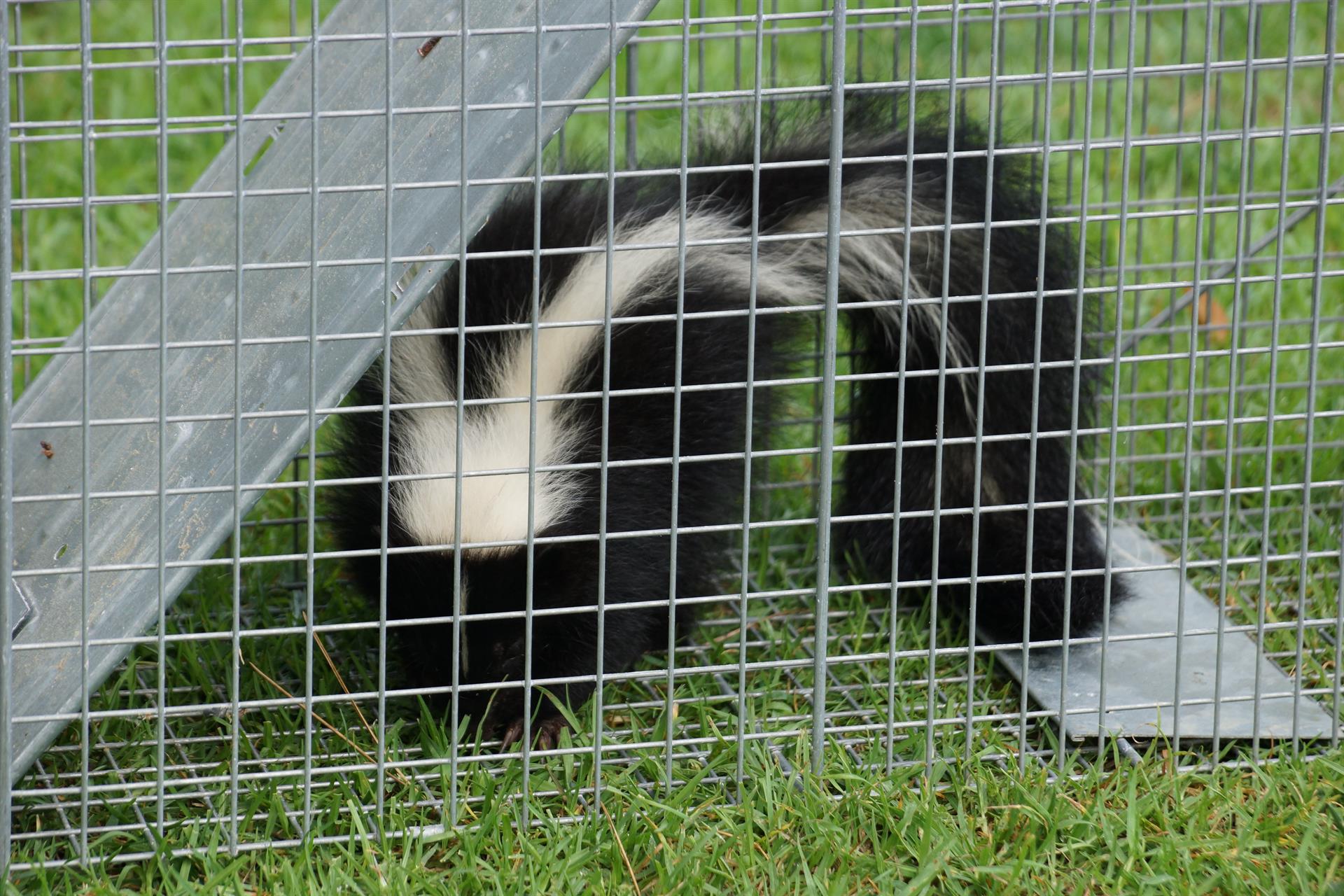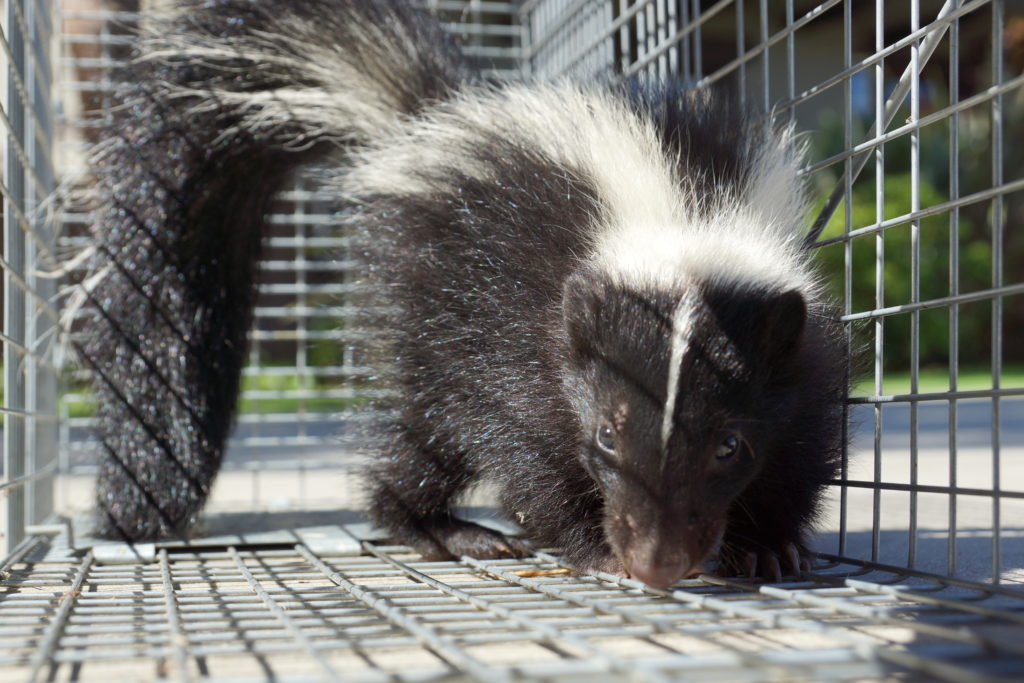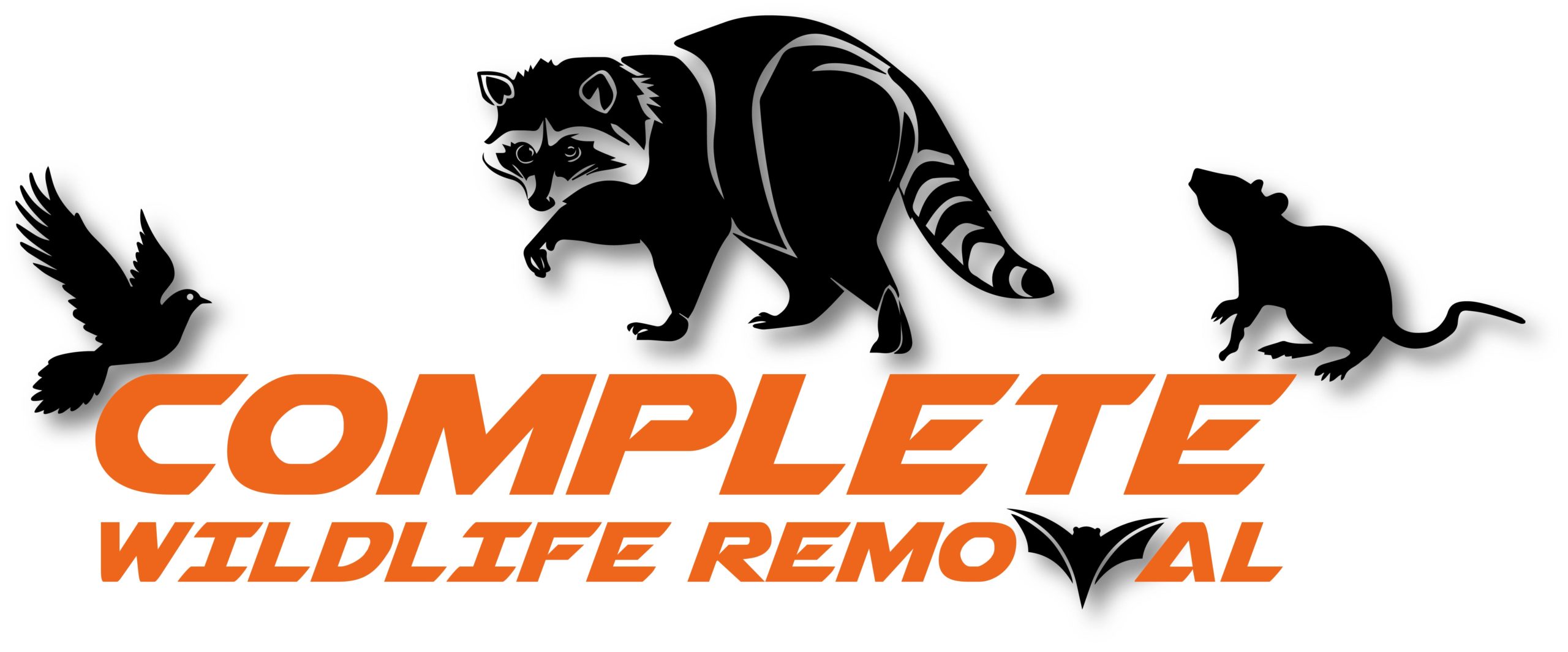Skunk Removal

Humane Skunk Removal
Skunks are an obvious threat to your home, and because of the risk of spray, if you provoke the animal, they can also be one of the more challenging pests to remove. Here’s what you need to know about skunk removal.

How skunks enter residential spaces
Skunks tend to live in the area underneath your home rather than inside your residential space itself. They often settle in open spaces below your building, but they can also accidentally enter basements and other low spaces through ground-level windows or entry points. They often enter looking for food or shelter and find your home to be a suitable place to make a den.
The potential damage caused by skunks
The most obvious potential damage caused by skunks is their spray, which is their line of defense against predators and which causes a pungent, unpleasant smell to permeate your home (and/or yourselves/your pets). The spray alone can cause thousands of dollars of property damage to your space.
However, skunks also pose a threat as the primary source of rabies in many areas of the US. For both of these reasons, it’s often safer to bring in a professional rather than trying to expel a skunk from your home alone.
Other damage can include skunk holes in your yard or garden, attacks on chickens or pets, and den developments under your decks, stairs, or your home’s foundation.

How to eliminate skunks from your home
The best approach to getting rid of skunks is to call in professionals to trap and remove the skunk from your home as soon as possible to prevent further damage or risk of spraying. At Complete Wildlife Removal, we’ll take care of this process by identifying the entry points that the skunks may be using to enter your home, trapping them or forcing them out, then carefully sealing off all entry points to prevent the skunks from returning. If the skunk has already sprayed within your home, we’ll also deodorize your space as part of our process.
Timeline, cost, and other factors
The timeline, cost, and effectiveness of this process depend on many factors, including how many skunks are in your home, whether they’re alive or dead, whether a den has been established, and how many possible entry points exist. If you’re located in Utah, Wyoming, or Idaho, give us a call for a free quote. We’re based out of Salt Lake City and Park City, but serve clients across all three states and would be happy to give a more specific estimate for your situation.
Long-term, you can make your space less attractive to skunks by monitoring and cleaning up any food sources like fallen fruit and cutting back shrubs and other overgrown greenery that could serve as shelter.
What Attracts Skunks to Your Property?
One of the things we’ve learned in our years taking care of various wildlife problems is that the first step everyone overlooks is getting rid of what’s attracting the wild animal in the first place. At Complete Wildlife Removal, we are often called upon to remove various wild animals like skunks, raccoons, and even snakes, from human properties. And one issue we keep seeing is the presence of common attraction points that the property owner has overlooked, unfortunately.
Removing things that attract skunks from your property can save you a lot of trouble, not to mention a lot of money, in the long run. This is why we’re writing this article.
So what are the things that are attracting skunks to your property?
Keep in mind that skunks are mostly nocturnal creatures since it’s a lot easier to roam undetected at night. As such, you’ll need to be vigilant and pay special attention if you want to detect the presence of a skunk on your property.
Food, food, food.
It’s pretty much a safe assumption that wild animals on your property have arrived looking for food. While the items they consider edible may vary from one animal to another, their need for sustenance will not. So, it’s quite likely that if you’ve got skunks on your property, it’s because you’ve made food readily available to them.
Skunks are known to feast on worms, grubs, larvae, and insects. And so, getting rid of these creatures may be trickier, since they’re pretty much guaranteed to be on your property.
Tip – this is also a good way to know if there are skunks prowling your yard since you’ll see little mounds of dirt, where the skunk dug up the slugs.
But skunks are omnivores, which means they won’t shy away from eating fruit, berries, nuts, and even leaves. So the presence of any of these objects might explain your skunk problem.
Holes, cracks, and hiding spaces.
Like most wild animals, skunks are also desperately looking for a safe and cozy place to call their home. This is why we advise our clients to regularly inspect the structure of their home, and check for holes and cracks that might allow a skunk entry. You want to fix these entry points as quickly as possible, though not before making sure there aren’t any wild animals that have come through already. Fixing a hole while an animal is still inside or under your property will lead to the animal’s slow and painful death, which will then cause an awful smell, and may also attract other wild animals. So if you’ve discovered a skunk’s entry point, but the skunk is still in there, you can either attempt exclusion or wait them out.
Exclusion refers to the installation of a one-way door over the entry point, which will allow the skunk to get out, but not it. So this can also be a worthwhile option if there are no baby skunks on the premises.
Messy yards aren’t a good idea.
Tallgrass and untrimmed bushes make for ideal hiding spots for skunks, which is why we recommend you get rid of them and keep your yard looking trim and tidy. And it’s not just skunks – snakes, rats, squirrels, and many other wild animals are more likely to visit an uncared-for yard! So do yourself a favor, and spend time performing regular yard maintenance.
You also want to keep wood log piles to a minimum, as they can also provide shelter to skunks and other wild animals. So find alternatives for storing these, or get rid of them altogether.

How to Remove Skunks in the Basement
Skunks are a nuisance when they enter your home. And while they have adjusted well to foraging from residential areas, they are obviously not pleasant neighbors, and you certainly don’t want them anywhere near your home. Skunks are notorious for spraying a foul-smelling odor that is very difficult to eliminate, and they can spray it accurately when they feel threatened by another animal or a person, plus you can smell it from 3.5 miles away, this is one of the most serious issues. It’s important to know how to get rid of skunks, but if you’re frightened or cautious about removing skunks from your basement, here are some good tips for you, although we always recommend that you get a professional to handle it for you.
Signs That You Have Skunks Around Your Property
The first sign that there are skunks on your property is usually the foul skunk smell, these animals do not only spray their greasy and stinking liquid when they feel threatened, but they also spray it to mark their territory. Therefore, when skunks take up residence on your property, they will pollute the air with their smelling liquid. In addition to this foul smell, you will also notice that your garbage cans get raided at night. Skunks are scavengers, and they will often raid trash cans under the cover of darkness in search of insects and food scrubs to eat. Skunks especially enjoy insects and grubs, so you may also see signs of animal activity on your lawn, such as digging shallow holes as they search for underground insects.
Trapping And Removing A Skunk
Getting rid of skunks can be very tricky because of the risk of getting sprayed. The awful smell of skunk spray is very tough to get rid of, and it can last for several weeks. Skunk removal is best left for professional wildlife control, but if you want to try your hands at DIY skunk removal, here are some tips for you.
Trapping a skunk and moving it to an area that is at least 10 miles away from your property is the best way to deal with it, and the easiest way to accomplish this is with a cage trap. You can purchase a skunk trap and bait it with bacon, sardines, mackerel, or grubs if you can find any.
The trap should then be set in a place where you have observed skunk activity, and it should be checked on a regular basis. To effectively trap and remove a skunk without getting sprayed, ensure that you cover the trap with a blanket and move it at an angle where the skunk can’t see you, this will reduce the risk of getting sprayed by an angry and defensive skunk.
Try a one-way exit door
If you’re just trying to get the skunk out of your house, a good alternative is to create a one-way exit for the skunk to leave on its own. To do this, you’ll need a cage trap with open ends and some durable chicken wire to wrap around the trap. You will need to first locate the skunk’s entry and exit point to your basement because this is where you will install the one-way trap door. After installing the one-way exit door, ensure that you always check it at least once every day, to see if it has been triggered. This trap door will allow the animal to exit your basement without getting back in. so once the skunk has safely exited the basement, you will need to remove the installation and seal off the hole.
Cleaning And Repairing The Area
After you’ve removed the skunk, you’ll probably see that there are some cleaning and repairs to be made. You can find a number of commercial or DIY products that can help with the odor. You can carefully clean up your basement and disinfect every corner to effectively remove every trace of smelly skunks.
Request Free Quote


